Computational Analysis of Nanoparticle Shapes on Hybrid Nanofluid Flow Due to Flat Horizontal Plate via Solar Collector
Abstract
:1. Introduction
2. Mathematical and Physical Descriptions
2.1. Governing Equations
2.2. Calculation of Rosseland Approximation
2.3. Similarity Transformations
2.4. Resulting Equations
2.5. Non-Dimensional Parameters
2.6. Physical Industrial Interest
2.7. Entropy of System
3. Numerical Algorithm (Shooting Scheme)
Validation of Results
4. Results and Discussion
5. Conclusions
Author Contributions
Funding
Data Availability Statement
Conflicts of Interest
Nomenclature
| Velocity components | |
| Cartesian coordinates | |
| Material constants | |
| Stretching velocity | |
| Dynamic viscosity | |
| Pressure | |
| Rivlin–Erickson tensors | |
| Identity tensor | |
| Time-dependent derivative | |
| Velocity of fluid | |
| Density of hybrid nanofluid | |
| Thermal conductivity of hybrid nanofluid | |
| Hybrid nanofluid heat capacity | |
| Specific heat | |
| Radiative heat flux | |
| Strength of Magnetic field | |
| Stefan–Boltzmann constant | |
| Mean absorption coefficient | |
| Second grade fluid parameter | |
| Porousity parameter | |
| Thermal radiation parameter | |
| Prandtl number | |
| Eckert number | |
| Magnetic parameter | |
| Suction/injection velocity | |
| Velocity ratio parameter | |
| Volume fraction of nanoparticles | |
| Temperature of the surface | |
| Neighborhood temperature | |
| Coefficient of skin friction | |
| Nusselt number | |
| Shear stress | |
| Heat flux | |
| Local Reynolds number | |
| Brinkman number | |
| Temperature gradient | |
| Entropy generation | |
| Thermophysical properties defined for hybrid nanofluid |
References
- Choi, S.U.; Eastman, J.A. Enhancing Thermal Conductivity of Fluids with Nanoparticles; FED; ASME: New York, NY, USA, 1995; Volume 66, pp. 99–105. [Google Scholar]
- Rasool, G.; Shafiq, A.; Khalique, C.M. Marangoni forced convective Casson type nanofluid flow in the presence of Lorentz force generated by Riga plate. Discret. Contin. Dyn. Syst. S 2021, 14, 2517. [Google Scholar] [CrossRef]
- Mahanthesh, B.; Mackolil, J. Flow of nanoliquid past a vertical plate with novel quadratic thermal radiation and quadratic Boussinesq approximation: Sensitivity analysis. Int. Commun. Heat Mass Transf. 2020, 120, 105040. [Google Scholar] [CrossRef]
- Ramzan, M.; Shaheen, N.; Chung, J.D.; Kadry, S.; Chu, Y.-M.; Howari, F. Impact of Newtonian heating and Fourier and Fick’s laws on a magnetohydrodynamic dusty Casson nanofluid flow with variable heat source/sink over a stretching cylinder. Sci. Rep. 2021, 11, 1–19. [Google Scholar] [CrossRef] [PubMed]
- Eid, M.R.; Mabood, F. Thermal analysis of higher-order chemical reactive viscoelastic nanofluids flow in porous media via stretching surface. Proc. Inst. Mech. Eng. Part C J. Mech. Eng. Sci. 2021, 235, 6099–6110. [Google Scholar] [CrossRef]
- Gowda, R.P.; Kumar, R.N.; Prasannakumara, B.; Nagaraja, B.; Gireesha, B. Exploring magnetic dipole contribution on ferromagnetic nanofluid flow over a stretching sheet: An application of Stefan blowing. J. Mol. Liq. 2021, 335, 116215. [Google Scholar] [CrossRef]
- Alsabery, A.; Tayebi, T.; Abosinnee, A.; Raizah, Z.; Chamkha, A.; Hashim, I. Impacts of Amplitude and Local Thermal Non-Equilibrium Design on Natural Convection within NanoflUid Superposed Wavy Porous Layers. Nanomaterials 2021, 11, 1277. [Google Scholar] [CrossRef]
- Alsabery, A.; Hajjar, A.; Sheremet, M.; Ghalambaz, M.; Hashim, I. Impact of particles tracking model of nanofluid on forced convection heat transfer within a wavy horizontal channel. Int. Commun. Heat Mass Transf. 2021, 122, 105176. [Google Scholar] [CrossRef]
- Khan, S.U.; Waqas, H.; Shehzad, S.A.; Imran, M. Theoretical analysis of tangent hyperbolic nanoparticles with combined electrical MHD, activation energy and Wu’s slip features: A mathematical model. Phys. Scr. 2019, 94, 125211. [Google Scholar] [CrossRef]
- Muhammad, T.; Waqas, H.; Khan, S.A.; Ellahi, R.; Sait, S.M. Significance of nonlinear thermal radiation in 3D Eyring–Powell nanofluid flow with Arrhenius activation energy. J. Therm. Anal. 2020, 143, 929–944. [Google Scholar] [CrossRef]
- Shafiq, A.; Khan, I.; Rasool, G.; Sherif, E.-S.M.; Sheikh, A.H. Influence of Single- and Multi-Wall Carbon Nanotubes on Magnetohydrodynamic Stagnation Point Nanofluid Flow over Variable Thicker Surface with Concave and Convex Effects. Mathematics 2020, 8, 104. [Google Scholar] [CrossRef] [Green Version]
- Waqas, H.; Yasmin, S.; Muhammad, T.; Imran, M. Flow and heat transfer of nanofluid over a permeable cylinder with nonlinear thermal radiation. J. Mater. Res. Technol. 2021, 14, 2579–2585. [Google Scholar] [CrossRef]
- Hayat, T.; Muhammad, T.; Shehzad, S.A.; Alsaedi, A. Similarity solution to three dimensional boundary layer flow of second grade nanofluid past a stretching surface with thermal radiation and heat source/sink. AIP Adv. 2015, 5, 017107. [Google Scholar] [CrossRef]
- Waqas, H.; Imran, M.; Muhammad, T.; Sait, S.M.; Ellahi, R. On bio-convection thermal radiation in Darcy—Forchheimer flow of nanofluid with gyrotactic motile microorganism under Wu’s slip over stretching cylinder/plate. Int. J. Numer. Methods Heat Fluid Flow 2020, 31, 1520–1546. [Google Scholar] [CrossRef]
- Wakif, A.; Chamkha, A.; Thumma, T.; Animasaun, I.L.; Sehaqui, R. Thermal radiation and surface roughness effects on the thermo-magneto-hydrodynamic stability of alumina–copper oxide hybrid nanofluids utilizing the generalized Buongiorno’s nanofluid model. J. Therm. Anal. 2020, 143, 1201–1220. [Google Scholar] [CrossRef]
- Hussain, A.; Hassan, A.; Al Mdallal, Q.; Ahmad, H.; Rehman, A.; Altanji, M.; Arshad, M. Heat transport investigation of magneto-hydrodynamics (SWCNT-MWCNT) hybrid nanofluid under the thermal radiation regime. Case Stud. Therm. Eng. 2021, 27, 101244. [Google Scholar] [CrossRef]
- Kerschbaumer, N.M.; Niedermaier, S.; Lohmüller, T.; Feldmann, J. Contactless and spatially structured cooling by directing thermal radiation. Sci. Rep. 2021, 11, 16209. [Google Scholar] [CrossRef]
- Alsabery, A.I.; Parvin, S.; Ghalambaz, M.; Chamkha, A.J.; Hashim, I. Convection Heat Transfer in 3D Wavy Direct Absorber Solar Collector Based on Two-Phase Nanofluid Approach. Appl. Sci. 2020, 10, 7265. [Google Scholar] [CrossRef]
- Han, W.; Chen, X. Nano-electrokinetic ion enrichment in a micro-nanofluidic preconcentrator with nanochannel’s Cantor fractal wall structure. Appl. Nanosci. 2019, 10, 95–105. [Google Scholar] [CrossRef]
- Han, W.; Chen, X. A review: Applications of ion transport in micro-nanofluidic systems based on ion concentration polarization. J. Chem. Technol. Biotechnol. 2019, 95, 1622–1631. [Google Scholar] [CrossRef]
- Waqas, H.; Khan, S.A.; Khan, S.U.; Khan, M.I.; Kadry, S.; Chu, Y.-M. Falkner-Skan time-dependent bioconvrction flow of cross nanofluid with nonlinear thermal radiation, activation energy and melting process. Int. Commun. Heat Mass Transf. 2020, 120, 105028. [Google Scholar] [CrossRef]
- Han, W.; Chen, X. Nano-electrokinetic ion enrichment of highly viscous fluids in micro-nanochannel. Chem. Eng. Process. Process Intensif. 2019, 143, 107626. [Google Scholar] [CrossRef]
- Eid, M.R.; Mabood, F. Two-phase permeable non-Newtonian cross-nanomaterial flow with Arrhenius energy and entropy generation: Darcy-Forchheimer model. Phys. Scr. 2020, 95, 105209. [Google Scholar] [CrossRef]
- Eid, M.R.; Mabood, F. Entropy analysis of a hydromagnetic micropolar dusty carbon NTs-kerosene nanofluid with heat generation: Darcy–Forchheimer scheme. J. Therm. Anal. 2021, 143, 2419–2436. [Google Scholar] [CrossRef]
- Turkyilmazoglu, M. Velocity Slip and Entropy Generation Phenomena in Thermal Transport Through Metallic Porous Channel. J. Non-Equilib. Thermodyn. 2020, 45, 247–256. [Google Scholar] [CrossRef]
- Shehzad, S.A.; Madhu, M.; Shashikumar, N.S.; Gireesha, B.J.; Mahanthesh, B. Thermal and entropy generation of non-Newtonian magneto-Carreau fluid flow in microchannel. J. Therm. Anal. 2020, 143, 2717–2727. [Google Scholar] [CrossRef]
- Hayat, T.; Haider, F.; Alsaedi, A.; Ahmad, B. Entropy generation analysis of Carreau fluid with entire new concepts of modified Darcy’s law and variable characteristics. Int. Commun Heat Mass Transf. 2021, 120, 105073. [Google Scholar] [CrossRef]
- Shah, Z.; Alzahrani, E.O.; Dawar, A.; Alghamdi, W.; Ullah, M.Z. Entropy Generation in MHD Second-Grade Nanofluid Thin Film Flow Containing CNTs with Cattaneo-Christov Heat Flux Model Past an Unsteady Stretching Sheet. Appl. Sci. 2020, 10, 2720. [Google Scholar] [CrossRef] [Green Version]
- Jawad, M.; Saeed, A.; Tassaddiq, A.; Khan, A.; Gul, T.; Kumam, P.; Shah, Z. Insight into the dynamics of second grade hybrid radiative nanofluid flow within the boundary layer subject to Lorentz force. Sci. Rep. 2021, 11, 4894. [Google Scholar] [CrossRef]
- Brewster, M.Q. Thermal Radiative Transfer and Properties; John Wiley & Sons: Hoboken, NJ, USA, 1992. [Google Scholar]
- Rafiq, M.; Kamran, M.; Ahmed, N.; Mohyud-Din, S.T.; Bashir, Y.; Haider, S.A.; Farwa, S.; Tahir, M. Analytical solution for the flow of second grade fluid over a stretching sheet. AIP Adv. 2019, 9, 055313. [Google Scholar] [CrossRef] [Green Version]
- Jamshed, W.; Mishra, S.; Pattnaik, P.; Nisar, K.S.; Devi, S.S.U.; Prakash, M.; Shahzad, F.; Hussain, M.; Vijayakumar, V. Features of entropy optimization on viscous second grade nanofluid streamed with thermal radiation: A Tiwari and Das model. Case Stud. Therm. Eng. 2021, 27, 101291. [Google Scholar] [CrossRef]

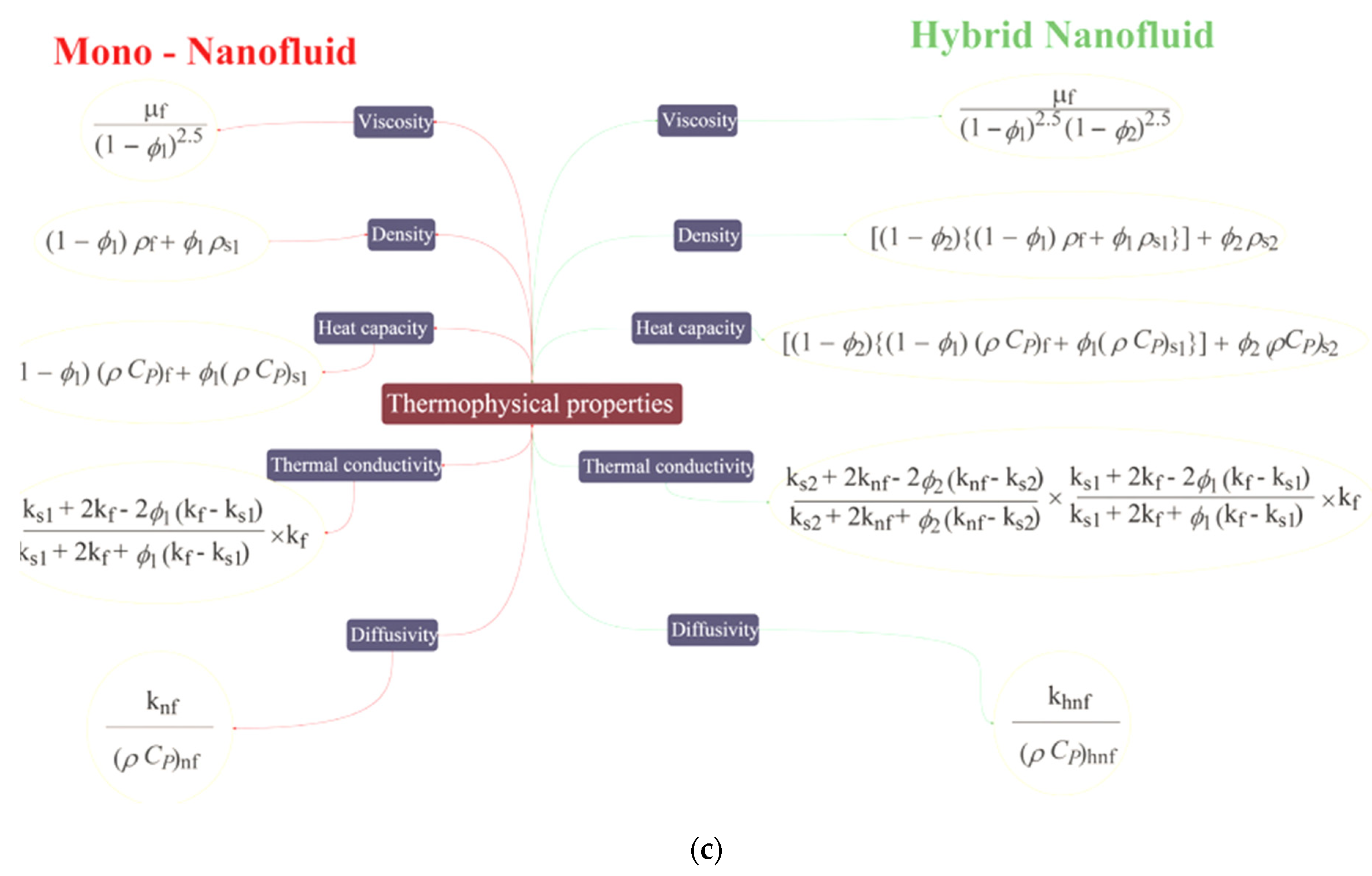
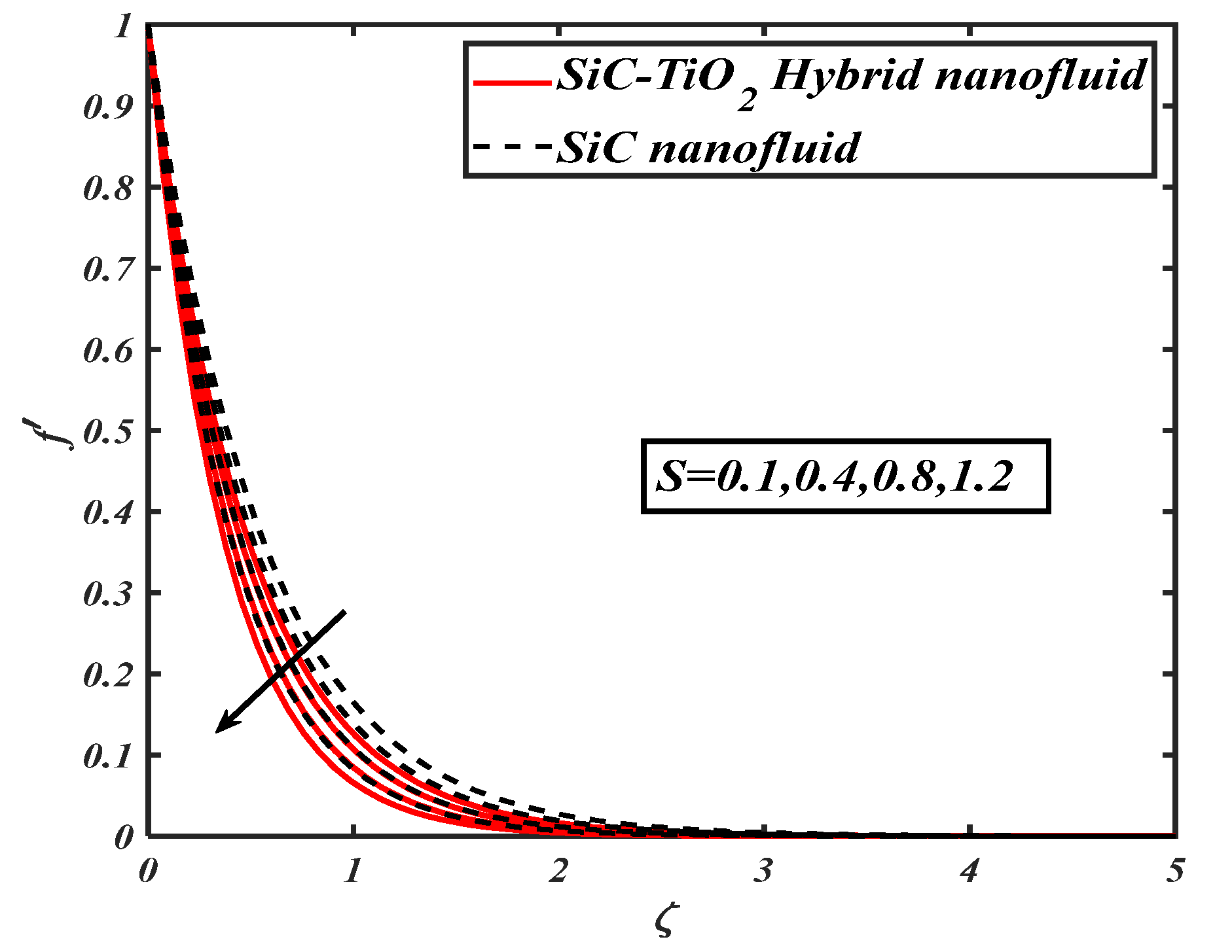
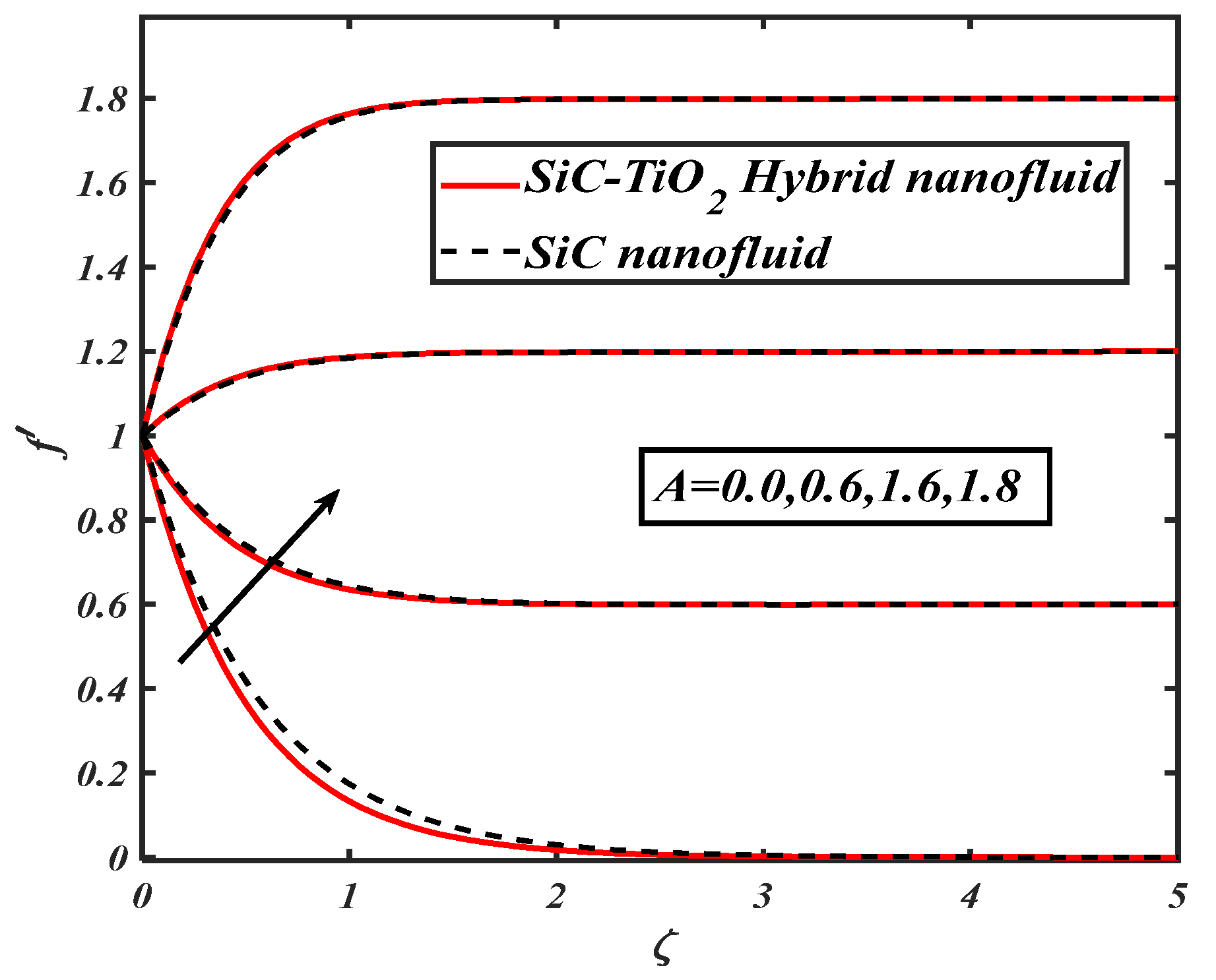
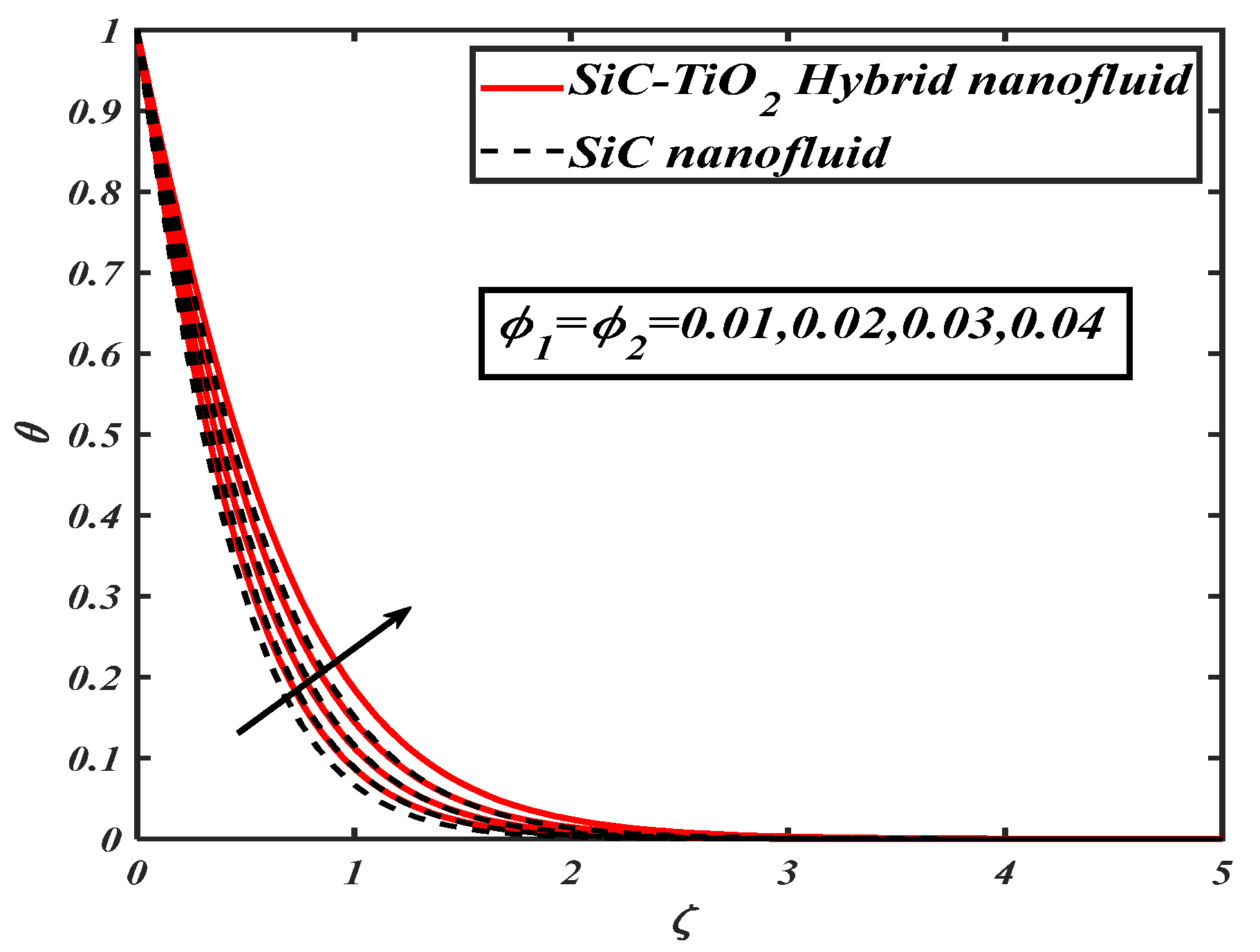
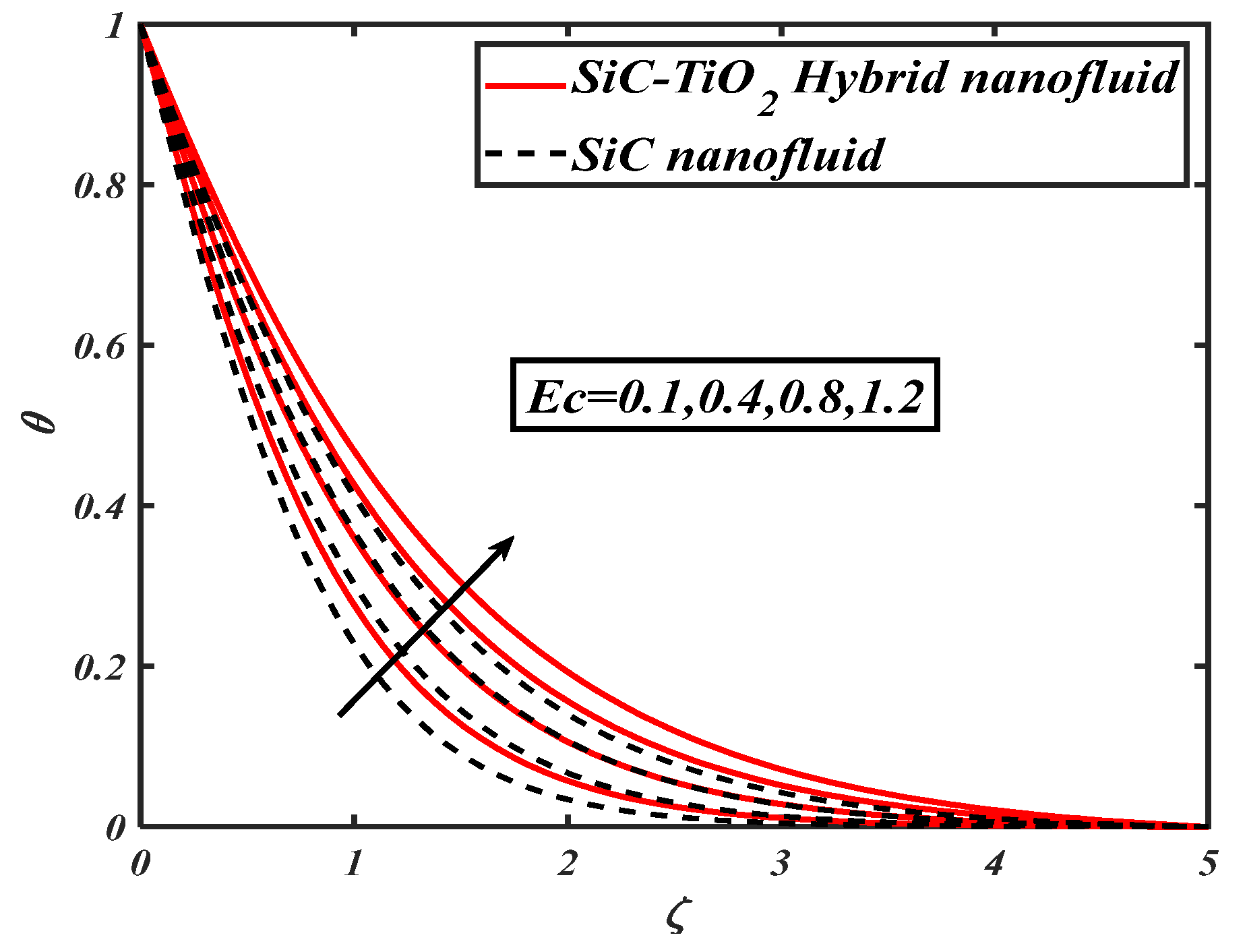


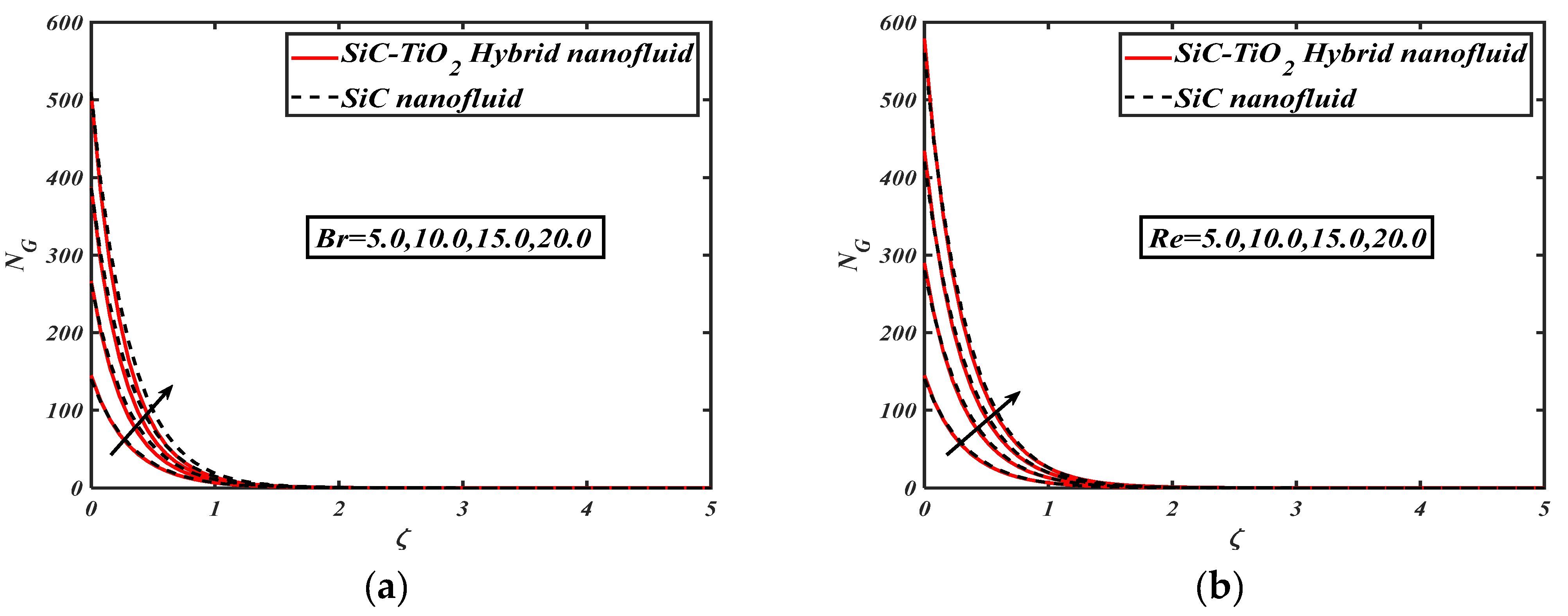
| Physical Characteristics | Kerosene Oil | ||
|---|---|---|---|
| 2090 | 1340 | 686.2 | |
| 783 | 3370 | 4250 | |
| 0.15 | 150 | 8.9638 | |
| -- |
| Nanoparticle Shape | Geometrical Appearance | Size | Sphericity |
|---|---|---|---|
| Sphere |  | 3.0 | 1.0 |
| Tetrahedron |  | 4.0613 | 0.82 |
| Bricks |  | 3.7 | 0.81 |
| Platelets |  | 5.7 | 0.52 |
Publisher’s Note: MDPI stays neutral with regard to jurisdictional claims in published maps and institutional affiliations. |
© 2022 by the authors. Licensee MDPI, Basel, Switzerland. This article is an open access article distributed under the terms and conditions of the Creative Commons Attribution (CC BY) license (https://creativecommons.org/licenses/by/4.0/).
Share and Cite
Imran, M.; Yasmin, S.; Waqas, H.; Khan, S.A.; Muhammad, T.; Alshammari, N.; Hamadneh, N.N.; Khan, I. Computational Analysis of Nanoparticle Shapes on Hybrid Nanofluid Flow Due to Flat Horizontal Plate via Solar Collector. Nanomaterials 2022, 12, 663. https://doi.org/10.3390/nano12040663
Imran M, Yasmin S, Waqas H, Khan SA, Muhammad T, Alshammari N, Hamadneh NN, Khan I. Computational Analysis of Nanoparticle Shapes on Hybrid Nanofluid Flow Due to Flat Horizontal Plate via Solar Collector. Nanomaterials. 2022; 12(4):663. https://doi.org/10.3390/nano12040663
Chicago/Turabian StyleImran, Muhammad, Sumeira Yasmin, Hassan Waqas, Shan Ali Khan, Taseer Muhammad, Nawa Alshammari, Nawaf N. Hamadneh, and Ilyas Khan. 2022. "Computational Analysis of Nanoparticle Shapes on Hybrid Nanofluid Flow Due to Flat Horizontal Plate via Solar Collector" Nanomaterials 12, no. 4: 663. https://doi.org/10.3390/nano12040663
APA StyleImran, M., Yasmin, S., Waqas, H., Khan, S. A., Muhammad, T., Alshammari, N., Hamadneh, N. N., & Khan, I. (2022). Computational Analysis of Nanoparticle Shapes on Hybrid Nanofluid Flow Due to Flat Horizontal Plate via Solar Collector. Nanomaterials, 12(4), 663. https://doi.org/10.3390/nano12040663








